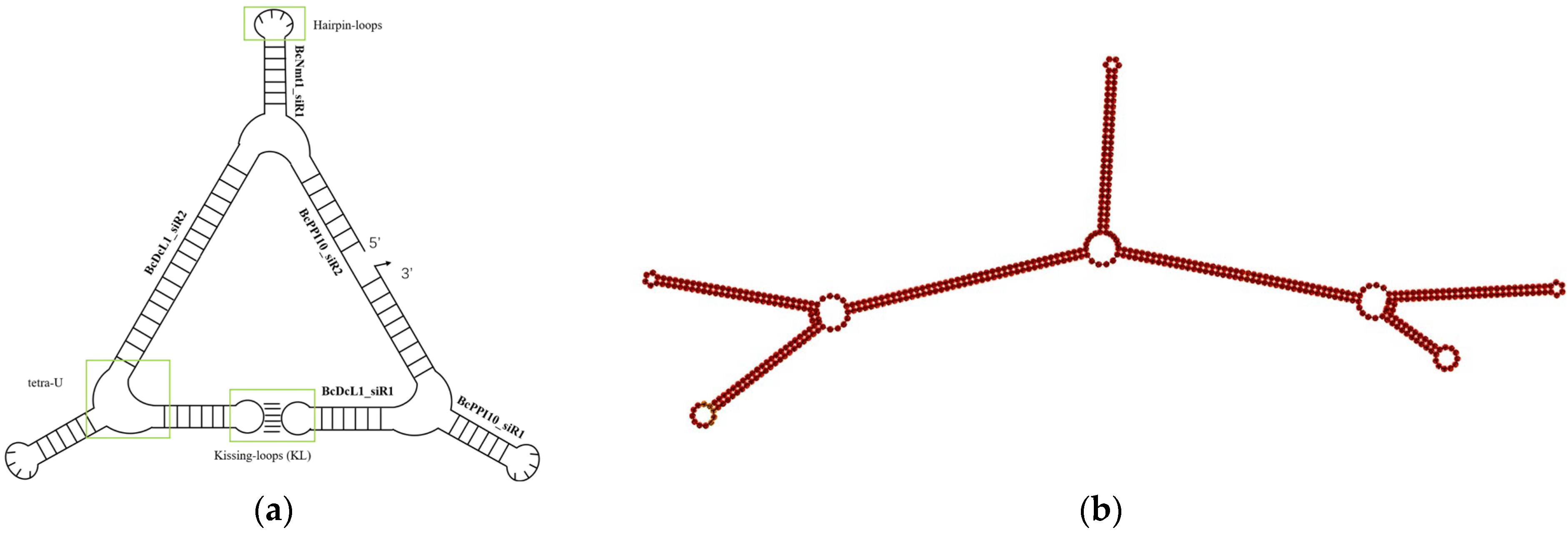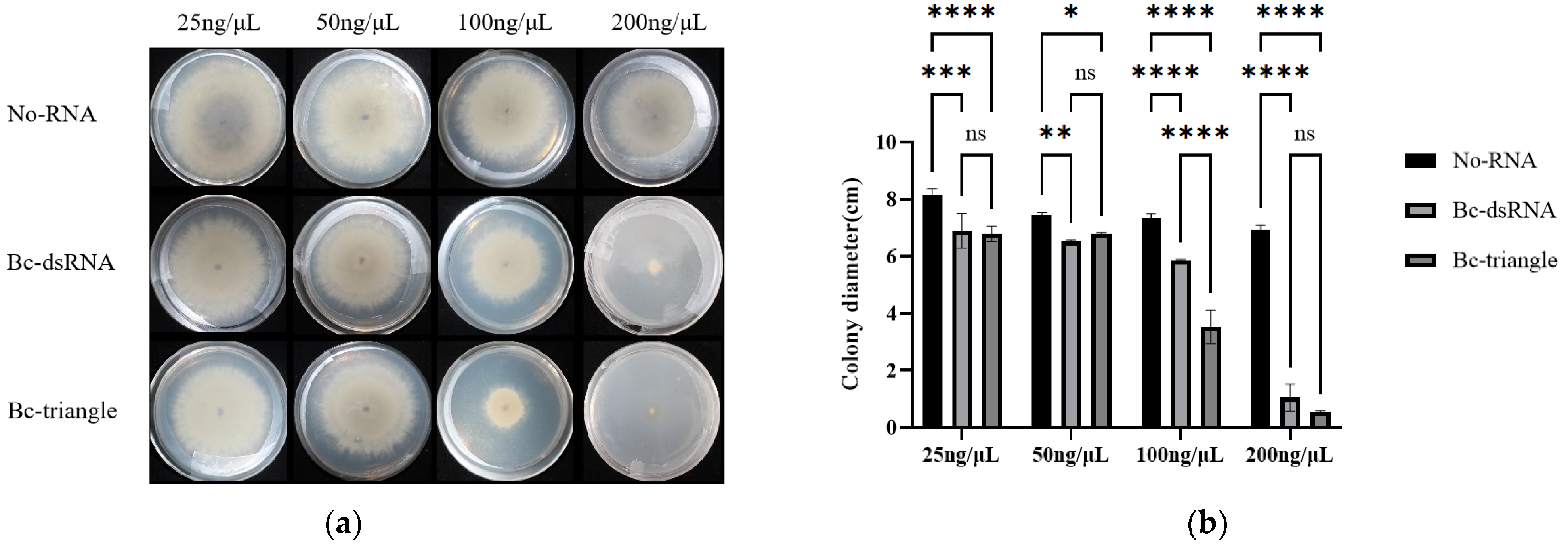Development of Triangle RNA Nanostructure for Enhancing RNAi-Mediated Control of Botrytis cinerea Through Spray-Induced Gene Silencing Without Extra Nanocarrier
Simple Summary
Abstract
1. Introduction
2. Materials and Methods
2.1. Preparation of Plant Materials and Botrytis cinerea
2.2. Design of RNA Nanoparticles
2.3. Plasmid Construction and RNA Nanoparticle Expression in E. coli
2.4. Spore Germination Assay
2.5. Mycelial Growth Inhibition Assay
2.6. In Planta Assay on Tobacco
2.7. Quantitative RT-PCR Analysis
2.8. Statistics Analysis
2.9. Cryo-EM Imaging
3. Results
3.1. Design and Production of B. cinerea-Targeted Triangle RNA Nanoparticles
3.2. Production of the Triangle RNA Nanoparticles
3.3. Bc-Triangle Strongly Inhibits B. cinerea Spore Germination
3.4. Suppression of Mycelial Growth by Bc-Triangle
3.5. Bc-Triangle Confers Enhanced Protection Against B. cinerea Infection in Planta
3.6. Bc-Triangle Enhances Gene Silencing Efficiency in B. cinerea
4. Discussion
5. Conclusions
Supplementary Materials
Author Contributions
Funding
Institutional Review Board Statement
Informed Consent Statement
Data Availability Statement
Conflicts of Interest
References
- Li, H.; Chen, Y.; Zhang, Z.; Li, B.; Qin, G.; Tian, S. Pathogenic Mechanisms and Control Strategies of Botrytis cinerea Causing Post-Harvest Decay in Fruits and Vegetables. Food Qual. Saf. 2018, 2, 111–119. [Google Scholar] [CrossRef]
- Shaw, M.W.; Emmanuel, C.J.; Emilda, D.; Terhem, R.B.; Shafia, A.; Tsamaidi, D.; Emblow, M.; Van Kan, J.A.L. Analysis of Cryptic, Systemic Botrytis Infections in Symptomless Hosts. Front. Plant Sci. 2016, 7, 625. [Google Scholar] [CrossRef]
- Spada, M.; Pugliesi, C.; Fambrini, M.; Pecchia, S. Silencing of the Slt2-Type MAP Kinase Bmp3 in Botrytis cinerea by Application of Exogenous dsRNA Affects Fungal Growth and Virulence on Lactuca sativa. Int. J. Mol. Sci. 2021, 22, 5362. [Google Scholar] [CrossRef]
- Ullah, I.; Yuan, W.; Khalil, H.B.; Khan, M.R.; Lak, F.; Uzair, M.; Abbas, A.; Mirzadi Gohari, A.; Wu, H. Understanding Botrytis cinerea Infection and Gray Mold Management: A Review Paper on Deciphering the Rose’s Thorn. Phytopathol. Res. 2024, 6, 42. [Google Scholar] [CrossRef]
- Spada, M.; Pugliesi, C.; Fambrini, M.; Pecchia, S. Challenges and Opportunities Arising from Host–Botrytis cinerea Interactions to Outline Novel and Sustainable Control Strategies: The Key Role of RNA Interference. Int. J. Mol. Sci. 2024, 25, 6798. [Google Scholar] [CrossRef]
- McLaughlin, M.S.; Roy, M.; Abbasi, P.A.; Carisse, O.; Yurgel, S.N.; Ali, S. Why Do We Need Alternative Methods for Fungal Disease Management in Plants? Plants 2023, 12, 3822. [Google Scholar] [CrossRef] [PubMed]
- Islam, M.T.; Sherif, S.M. RNAi-Based Biofungicides as a Promising Next-Generation Strategy for Controlling Devastating Gray Mold Diseases. Int. J. Mol. Sci. 2020, 21, 2072. [Google Scholar] [CrossRef]
- Wu, F.; Yan, L.; Zhao, X.; Lv, C.; Jin, W. Development of an RNA Nanostructure for Effective Botrytis cinerea Control through Spray-Induced Gene Silencing without an Extra Nanocarrier. J. Fungi 2024, 10, 483. [Google Scholar] [CrossRef]
- Nerva, L.; Sandrini, M.; Gambino, G.; Chitarra, W. Double-Stranded RNAs (dsRNAs) as a Sustainable Tool against Gray Mold (Botrytis cinerea) in Grapevine: Effectiveness of Different Application Methods in an Open-Air Environment. Biomolecules 2020, 10, 200. [Google Scholar] [CrossRef]
- Qiao, L.; Lan, C.; Capriotti, L.; Ah-Fong, A.; Nino Sanchez, J.; Hamby, R.; Heller, J.; Zhao, H.; Glass, N.L.; Judelson, H.S.; et al. Spray-induced Gene Silencing for Disease Control Is Dependent on the Efficiency of Pathogen RNA Uptake. Plant Biotechnol. J. 2021, 19, 1756–1768. [Google Scholar] [CrossRef]
- Qiao, L.; Niño-Sánchez, J.; Hamby, R.; Capriotti, L.; Chen, A.; Mezzetti, B.; Jin, H. Artificial Nanovesicles for dsRNA Delivery in Spray-Induced Gene Silencing for Crop Protection. Plant Biotechnol. J. 2023, 21, 854–865. [Google Scholar] [CrossRef]
- Spada, M.; Pugliesi, C.; Fambrini, M.; Palpacelli, D.; Caneo, A.; Pecchia, S. Spray-Induced Gene Silencing (SIGS): Nanocarrier-Mediated dsRNA Delivery Improves RNAi Efficiency in the Management of Lettuce Gray Mold Caused by Botrytis cinerea. Agronomy 2025, 15, 194. [Google Scholar] [CrossRef]
- Verma, K.; Modgil, M. RNA Interference (RNAi) Mediated Technique for Combating Plant Diseases: Harnessing Nanoparticles for Effective Delivery and Enhanced Efficacy. Plant Cell Tissue Organ Cult. PCTOC 2024, 157, 53. [Google Scholar] [CrossRef]
- Capriotti, L.; Molesini, B.; Pandolfini, T.; Jin, H.; Baraldi, E.; Cecchin, M.; Mezzetti, B.; Sabbadini, S. RNA Interference-Based Strategies to Control Botrytis cinerea Infection in Cultivated Strawberry. Plant Cell Rep. 2024, 43, 201. [Google Scholar] [CrossRef]
- Li, M.; Zheng, M.; Wu, S.; Tian, C.; Liu, D.; Weizmann, Y.; Jiang, W.; Wang, G.; Mao, C. In Vivo Production of RNA Nanostructures via Programmed Folding of Single-Stranded RNAs. Nat. Commun. 2018, 9, 2196. [Google Scholar] [CrossRef] [PubMed]
- Wang, M.; Weiberg, A.; Lin, F.-M.; Thomma, B.P.H.J.; Huang, H.-D.; Jin, H. Bidirectional Cross-Kingdom RNAi and Fungal Uptake of External RNAs Confer Plant Protection. Nat. Plants 2016, 2, 16151. [Google Scholar] [CrossRef] [PubMed]
- Wu, F.; Huang, Y.; Jiang, W.; Jin, W. Genome-Wide Identification and Validation of Tomato-Encoded sRNA as the Cross-Species Antifungal Factors Targeting the Virulence Genes of Botrytis cinerea. Front. Plant Sci. 2023, 14, 1072181. [Google Scholar] [CrossRef] [PubMed]
- Vert, J.-P.; Foveau, N.; Lajaunie, C.; Vandenbrouck, Y. An Accurate and Interpretable Model for siRNA Efficacy Prediction. BMC Bioinform. 2006, 7, 520. [Google Scholar] [CrossRef]
- BLAST: Basic Local Alignment Search Tool. Available online: https://blast.ncbi.nlm.nih.gov/Blast.cgi (accessed on 2 July 2025).
- RNAfold Web Server. Available online: http://rna.tbi.univie.ac.at/cgi-bin/RNAWebSuite/RNAfold.cgi (accessed on 2 July 2025).
- Livak, K.J.; Schmittgen, T.D. Analysis of Relative Gene Expression Data Using Real-Time Quantitative PCR and the 2−ΔΔCT Method. Methods 2001, 25, 402–408. [Google Scholar] [CrossRef]
- Leroch, M.; Kleber, A.; Silva, E.; Coenen, T.; Koppenhöfer, D.; Shmaryahu, A.; Valenzuela, P.D.T.; Hahn, M. Transcriptome Profiling of Botrytis cinerea Conidial Germination Reveals Upregulation of Infection-Related Genes during the Prepenetration Stage. Eukaryot. Cell 2013, 12, 614–626. [Google Scholar] [CrossRef]
- Yang, X.; Zhang, Y.; Zhou, J.; Dong, H.; Bai, X.; Liu, W.; Gu, Z. Pathogenicity, Infection Process, Physiological and Biochemical Effects of Metarhizium rileyi against Spodoptera frugiperda (J.E. Smith) (Lepidoptera: Noctuidae) Larvae. Egypt. J. Biol. Pest Control 2024, 34, 19. [Google Scholar] [CrossRef]
- Li, M.; Sun, X.; Yin, M.; Shen, J.; Yan, S. Recent Advances in Nanoparticle-Mediated Co-Delivery System: A Promising Strategy in Medical and Agricultural Field. Int. J. Mol. Sci. 2023, 24, 5121. [Google Scholar] [CrossRef]
- Wang, Y.; Yan, Q.; Lan, C.; Tang, T.; Wang, K.; Shen, J.; Niu, D. Nanoparticle Carriers Enhance RNA Stability and Uptake Efficiency and Prolong the Protection against Rhizoctonia solani. Phytopathol. Res. 2023, 5, 2. [Google Scholar] [CrossRef]
- He, L.; Huang, Y.; Tang, X. RNAi-Based Pest Control: Production, Application and the Fate of dsRNA. Front. Bioeng. Biotechnol. 2022, 10, 1080576. [Google Scholar] [CrossRef] [PubMed]
- Hoang, B.T.L.; Fletcher, S.J.; Brosnan, C.A.; Ghodke, A.B.; Manzie, N.; Mitter, N. RNAi as a Foliar Spray: Efficiency and Challenges to Field Applications. Int. J. Mol. Sci. 2022, 23, 6639. [Google Scholar] [CrossRef]
- McLoughlin, A.G.; Wytinck, N.; Walker, P.L.; Girard, I.J.; Rashid, K.Y.; de Kievit, T.; Fernando, W.G.D.; Whyard, S.; Belmonte, M.F. Identification and Application of Exogenous dsRNA Confers Plant Protection against Sclerotinia sclerotiorum and Botrytis cinerea. Sci. Rep. 2018, 8, 7320. [Google Scholar] [CrossRef]
- Pérez-Pizá, M.C.; Sautua, F.J.; Szparaga, A.; Bohata, A.; Kocira, S.; Carmona, M.A. New Tools for the Management of Fungal Pathogens in Extensive Cropping Systems for Friendly Environments. Crit. Rev. Plant Sci. 2024, 43, 63–93. [Google Scholar] [CrossRef]
- Niño-Sánchez, J.; Sambasivam, P.T.; Sawyer, A.; Hamby, R.; Chen, A.; Czislowski, E.; Li, P.; Manzie, N.; Gardiner, D.M.; Ford, R.; et al. BioClayTM Prolongs RNA Interference-Mediated Crop Protection against Botrytis cinerea. J. Integr. Plant Biol. 2022, 64, 2187–2198. [Google Scholar] [CrossRef]






| siRNA-Name | siRNA Sequence | Bc-Triangle |
|---|---|---|
| BcDCL1_siR1 | ATTATCTCTAGCATCTACCGG | GGTAGATGCTAGAGACTTTTGCCTTGAACATCAGAACGAGGGCGACCCGCAAGGGTCGCCCTCGTTCTGATGTTCAAGGCTTTTGGCGCCGCATCTCGATGGTCAGAATTCACCGGTAGATGCTAGAGACTTTTGCCTAGATGAACAAGTATGCCGGATGGCGCAAGCCATCCGGCATACTTGTTCATCTAGGCTTTTGGGACACGACGATGAGAATAAGACATCAATGACCTGATGATGTCTTATTCTCATCGTCGTGTCCCTTTTGTCTCTAGCATCTACCGGTGAATTCTGACCATCGAGATGCGGCGCCTTTTGTCTCTAGCATCTACCGGTGAATTATCTCTAGCATCTACCGGTGACTTTTGTCTCTAGCATCATGACCTGAGATGCTAGAGACTTTTGCCATTCTTCCTATCCACCTCCAAAGCCGCAAGGCTTTGGAGGTGGATAGGAAGAATGGCTTTTGTCACCGGTAGATGCTAGAGATAATTCAC |
| BcDCL1_siR2 | TAGATGAACAAGTATGCCGGA | |
| BcPPI10_siR1 | ATTCTTCCTATCCACCTCCAA | |
| BcPPI10_siR2 | ATTCTGACCATCGAGATGCGG | |
| BcNMT1_siR1 | TTGAACATCAGAACGAGGGCG | |
| BcBAC_siR1 | TGTCTTATTCTCATCGTCGTG |
Disclaimer/Publisher’s Note: The statements, opinions and data contained in all publications are solely those of the individual author(s) and contributor(s) and not of MDPI and/or the editor(s). MDPI and/or the editor(s) disclaim responsibility for any injury to people or property resulting from any ideas, methods, instructions or products referred to in the content. |
© 2025 by the authors. Licensee MDPI, Basel, Switzerland. This article is an open access article distributed under the terms and conditions of the Creative Commons Attribution (CC BY) license (https://creativecommons.org/licenses/by/4.0/).
Share and Cite
Chen, Y.; Liu, Y.; Huang, Y.; Wu, F.; Jin, W. Development of Triangle RNA Nanostructure for Enhancing RNAi-Mediated Control of Botrytis cinerea Through Spray-Induced Gene Silencing Without Extra Nanocarrier. Biology 2025, 14, 1616. https://doi.org/10.3390/biology14111616
Chen Y, Liu Y, Huang Y, Wu F, Jin W. Development of Triangle RNA Nanostructure for Enhancing RNAi-Mediated Control of Botrytis cinerea Through Spray-Induced Gene Silencing Without Extra Nanocarrier. Biology. 2025; 14(11):1616. https://doi.org/10.3390/biology14111616
Chicago/Turabian StyleChen, Ya, Yiqing Liu, Yani Huang, Fangli Wu, and Weibo Jin. 2025. "Development of Triangle RNA Nanostructure for Enhancing RNAi-Mediated Control of Botrytis cinerea Through Spray-Induced Gene Silencing Without Extra Nanocarrier" Biology 14, no. 11: 1616. https://doi.org/10.3390/biology14111616
APA StyleChen, Y., Liu, Y., Huang, Y., Wu, F., & Jin, W. (2025). Development of Triangle RNA Nanostructure for Enhancing RNAi-Mediated Control of Botrytis cinerea Through Spray-Induced Gene Silencing Without Extra Nanocarrier. Biology, 14(11), 1616. https://doi.org/10.3390/biology14111616






